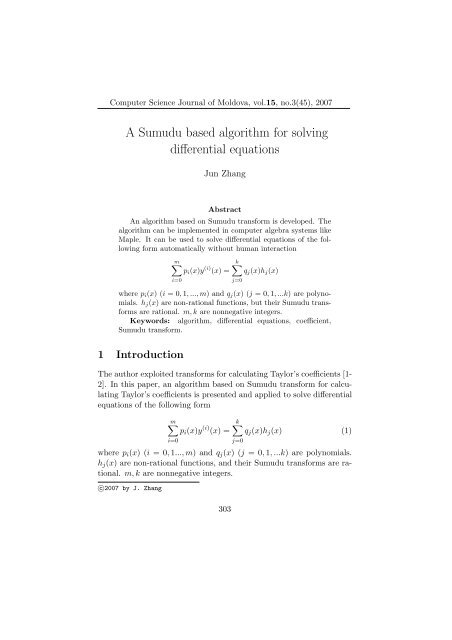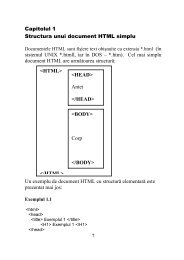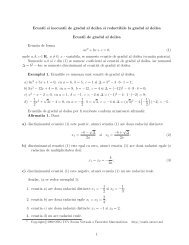A Sumudu based algorithm for solving differential equations
A Sumudu based algorithm for solving differential equations
A Sumudu based algorithm for solving differential equations
You also want an ePaper? Increase the reach of your titles
YUMPU automatically turns print PDFs into web optimized ePapers that Google loves.
Computer Science Journal of Moldova, vol.15, no.3(45), 2007<br />
A <strong>Sumudu</strong> <strong>based</strong> <strong>algorithm</strong> <strong>for</strong> <strong>solving</strong><br />
<strong>differential</strong> <strong>equations</strong><br />
Jun Zhang<br />
Abstract<br />
An <strong>algorithm</strong> <strong>based</strong> on <strong>Sumudu</strong> trans<strong>for</strong>m is developed. The<br />
<strong>algorithm</strong> can be implemented in computer algebra systems like<br />
Maple. It can be used to solve <strong>differential</strong> <strong>equations</strong> of the following<br />
<strong>for</strong>m automatically without human interaction<br />
m<br />
pi(x)y (i) (x) =<br />
i=0<br />
k<br />
qj(x)hj(x)<br />
where pi(x) (i = 0, 1, ..., m) and qj(x) (j = 0, 1, ...k) are polynomials.<br />
hj(x) are non-rational functions, but their <strong>Sumudu</strong> trans<strong>for</strong>ms<br />
are rational. m, k are nonnegative integers.<br />
Keywords: <strong>algorithm</strong>, <strong>differential</strong> <strong>equations</strong>, coefficient,<br />
<strong>Sumudu</strong> trans<strong>for</strong>m.<br />
1 Introduction<br />
The author exploited trans<strong>for</strong>ms <strong>for</strong> calculating Taylor’s coefficients [1-<br />
2]. In this paper, an <strong>algorithm</strong> <strong>based</strong> on <strong>Sumudu</strong> trans<strong>for</strong>m <strong>for</strong> calculating<br />
Taylor’s coefficients is presented and applied to solve <strong>differential</strong><br />
<strong>equations</strong> of the following <strong>for</strong>m<br />
j=0<br />
m<br />
pi(x)y<br />
i=0<br />
(i) k<br />
(x) = qj(x)hj(x) (1)<br />
j=0<br />
where pi(x) (i = 0, 1..., m) and qj(x) (j = 0, 1, ...k) are polynomials.<br />
hj(x) are non-rational functions, and their <strong>Sumudu</strong> trans<strong>for</strong>ms are rational.<br />
m, k are nonnegative integers.<br />
c○2007 by J. Zhang<br />
303
J. Zhang<br />
For a given function f(x), quite a few theorems exist about how to<br />
find the coefficient an of a general term anxn in the expansion, which<br />
we shall denote [xn ]f(x) or [xn ]f. Under some conditions, we have<br />
Taylor’s <strong>for</strong>mula:<br />
an = [x n ]f(x) = f (n) (0)<br />
. (2)<br />
n!<br />
This is a very nice <strong>for</strong>mula and can be quite useful in finding a specific<br />
term such as [x 3 ]f(x). However, <strong>for</strong> an arbitrary number n (usually<br />
considered to be very large), we cannot use the <strong>for</strong>mula directly to<br />
determine [x n ]f(x).<br />
If f(x) is a rational function, we can apply the methods in [8-10] to<br />
calculate [x n ]f(x). If f(x) is a non-rational function, it is difficult in<br />
practice to calculate [x n ]f(x). This work is to provide an approach<br />
to calculate Maclaurin coefficients <strong>for</strong> non rational functions automatically<br />
<strong>based</strong> on <strong>Sumudu</strong> trans<strong>for</strong>m, and then applied to solve equation<br />
(1).<br />
2 <strong>Sumudu</strong> Trans<strong>for</strong>m<br />
There are numerous integral <strong>based</strong> trans<strong>for</strong>ms, one was studied and<br />
named <strong>Sumudu</strong> trans<strong>for</strong>m by Watugala [7] in 1993. Since then, many<br />
works dedicated on <strong>Sumudu</strong> trans<strong>for</strong>m were done by F. B. M. Belgacem<br />
and others recently[3-7].<br />
Assume that function f is a function of x.<br />
trans<strong>for</strong>m as<br />
We write the <strong>Sumudu</strong><br />
∞ 1<br />
F (z) = S[f(x)] =<br />
z e−x/zf(x)dx. (3)<br />
We shall refer to f(x) as the original function of F (z) and F (z) as the<br />
<strong>Sumudu</strong> trans<strong>for</strong>m of the function f(x). We also refer to f(x) as the<br />
inverse <strong>Sumudu</strong> trans<strong>for</strong>m of F (z). The symbol S denotes the <strong>Sumudu</strong><br />
trans<strong>for</strong>m. The function 1<br />
z e−x/z is called the kernel of the trans<strong>for</strong>m.<br />
0<br />
304
A <strong>Sumudu</strong> <strong>based</strong> <strong>algorithm</strong> <strong>for</strong> <strong>solving</strong> <strong>differential</strong> <strong>equations</strong><br />
The following are a few basic properties of the <strong>Sumudu</strong> trans<strong>for</strong>m<br />
[3],<br />
(1) Linearity<br />
(2) Convolution<br />
S[c1f(x) + c2g(x)] = c1S[f(x)] + c2S[g(x)]. (4)<br />
S[(f ∗ g)(x)] = zS[f(x)] ∗ S[g(x)]. (5)<br />
(3) Laplace − <strong>Sumudu</strong> Duality<br />
L[f(x)] = S[f(1/x)]/z, F [f(x)] = L[f(1/x)]/z. (6)<br />
(4) Derivative<br />
S[f (m) (x)] = S[f(x])/z m − f(0)/z m − ... − f m−1 (0)/z.<br />
(7)<br />
A very interesting fact about <strong>Sumudu</strong> trans<strong>for</strong>m is that the original<br />
function and its <strong>Sumudu</strong> trans<strong>for</strong>m have the same Taylor coefficients<br />
except a factor n!. This fact is illustrated by the following theorems:<br />
Theorem 2.1 [11]: If<br />
1. f(x) is bounded and continuous,<br />
2. F (z) = S[f(x)], and,<br />
3. F (z) = ∞ n=0 anz n ,<br />
then we have<br />
∞ x<br />
f(x) = an<br />
n=0<br />
n<br />
. (8)<br />
n!<br />
305
J. Zhang<br />
Theorem 2.2 [4]: The <strong>Sumudu</strong> trans<strong>for</strong>m amplifies the coefficients of<br />
the power series function,<br />
by sending it to the power series function,<br />
∞<br />
f(x) = anx<br />
n=0<br />
n , (9)<br />
∞<br />
S[f(z)] = n!anz<br />
n=0<br />
n . (10)<br />
On another hand side, generating functions are a very important<br />
technic in study discrete mathematics. For a given sequence an, there<br />
are two classic generating functions:<br />
∞<br />
g(x) = anx<br />
n=0<br />
n ∞ an<br />
, l(x) =<br />
n!<br />
n=0<br />
xn . (11)<br />
The first one is called the ordinary generating function of the sequence<br />
an and the second one is its exponential generating function.<br />
Theorem 2.1 and theorem 2.2 are inverse to each other and give a<br />
complete relationship about coefficients under trans<strong>for</strong>m. Based on<br />
theorem 2.1 and theorem 2.2, we have another interesting fact about<br />
<strong>Sumudu</strong> trans<strong>for</strong>m:<br />
Proposition 2.3 <strong>Sumudu</strong> trans<strong>for</strong>m of an exponential generating<br />
function is its ordinary generating function; the inverse <strong>Sumudu</strong> trans<strong>for</strong>m<br />
of an ordinary generating function is its exponential generating<br />
function.<br />
These theorems can serve as a base to calculate the general term of a<br />
Taylor series expansion.<br />
3 Calculation theory<br />
Theorem 3.1: Assume f has a continuous derivative of order n in<br />
some open interval I containing 0, and define En(x) <strong>for</strong> x in I by the<br />
306
A <strong>Sumudu</strong> <strong>based</strong> <strong>algorithm</strong> <strong>for</strong> <strong>solving</strong> <strong>differential</strong> <strong>equations</strong><br />
equation<br />
f(x) =<br />
n−1<br />
<br />
k=0<br />
f (k) (0)<br />
x<br />
k!<br />
k + En(x).<br />
Then En(x) is called the Lagrange Remainder of order n, given by the<br />
integral<br />
<br />
1 x<br />
En(x) =<br />
(x − t)<br />
(n − 1)! 0<br />
n−1 f n (t)dt,<br />
En(x) can be written in another <strong>for</strong>m,<br />
<strong>for</strong> some c between 0 and x.<br />
Then we have the following:<br />
En(x) = f (n) (c)<br />
(n)! xn .<br />
[x n ]f(x) = [x n ]En(x).<br />
Assume f and g are functions of x, a and b are constants, d is a<br />
nonnegative integer, then,<br />
Proposition 3.2 (Linear Pairs)<br />
[x n ](af + bg) = a([x n ]f) + b([x n ]g),<br />
[z n ](S[af + bg]) = a([z n ]S[f]) + b([z n ]S[g]).<br />
The first <strong>for</strong>mula of linear pairs can be obtained from theorem 3.1<br />
directly, and the second one from the linear property of <strong>Sumudu</strong> trans<strong>for</strong>m.<br />
Theorem 3.3: Assume that the power series ∞ n=0 anx n converges<br />
<strong>for</strong> each x ∈ B(0, R). Then the function f defined by the equation<br />
∞<br />
f(x) = anx<br />
n=0<br />
n , x ∈ B(0, R),<br />
307
J. Zhang<br />
has a continuous derivative f ′ (x) <strong>for</strong> each x, |x| < R, given by<br />
f ′ ∞<br />
(x) = nanx<br />
n=1<br />
n−1 . x ∈ B(0, R).<br />
It is important to know that the series ∞ n=0 anx n and ∞ n=1 nanx n−1<br />
have the same radius of convergence, as can be shown by applying the<br />
Root Test, which can be found in many books.<br />
Proposition 3.4 (Derivative Pairs)<br />
[x n ]f (d) = ((n + d)(n + d − 1)...(n + 1))([x n+d ]f),<br />
[z n ]S[f (d) ] = [z n+d ]S[f].<br />
The first <strong>for</strong>mula in derivative pairs can be derived by applying theorem<br />
3.3 repeatedly <strong>for</strong> d times. The second can be easily verified by<br />
applying the <strong>Sumudu</strong> derivative property above. Obviously, we assume<br />
d is a positive integer and n > d in this situation.<br />
Suppose p(z) and g(z) have Taylor series expansions<br />
p(z) = p0 + p1z + p2z 2 + · · · + plz l<br />
g(z) = b0 + b1z + b2z 2 + · · · + bnz n + · · ·<br />
where pl = 0 and l is a non-negative integer.<br />
Proposition 3.5: If f(z) = p(z)g(z), we can compute [z n ]f(z) by<br />
comparing coefficients,<br />
[z n ]f(z) =<br />
m<br />
pkbn−k. (12)<br />
k=0<br />
4 The <strong>algorithm</strong> and implementation<br />
The purpose of this paper is to solve the <strong>equations</strong> of <strong>for</strong>m (1). In<br />
this paper, we assume that hj(x) are non-rational functions, but their<br />
308
A <strong>Sumudu</strong> <strong>based</strong> <strong>algorithm</strong> <strong>for</strong> <strong>solving</strong> <strong>differential</strong> <strong>equations</strong><br />
<strong>Sumudu</strong> trans<strong>for</strong>ms S[hj] are rational. There are a lot of such functions<br />
[1]. For example: e x , sin(x), e x cos(x), sin (40) (x).<br />
Assume <strong>for</strong>m (1) has a solution which can be expanded to<br />
y(x) = r0 + r1x + ... + rnx n + ... (13)<br />
Based on the theorems and propositions above, by comparing coefficients,<br />
we can calculate the coefficient of the general term rn <strong>for</strong> the<br />
solution y(x) as following:<br />
(1) Calculate ci = [x n ]piy (i) by proposition 3.4 and 3.5. <strong>for</strong><br />
i = 0, ..., m.<br />
(2) Add s = m i=0 ci.<br />
(3) Calculate the <strong>Sumudu</strong> trans<strong>for</strong>m S[hj(x)], <strong>for</strong><br />
j = 0, ..., k.<br />
(4) Calculate the tj = [x n ]qjhj by theorem 2.1 and<br />
proposition 3.5 .<br />
(5) Add t = k j=0 tj.<br />
(6) Calculate some small ri as initial values by comparing<br />
coefficients.<br />
(7) Solve the linear difference equation s = t,with initial<br />
values from (6), return rn.<br />
Example Let’s look at the following example. Assume<br />
p0(x) = 1 + x,<br />
p1(x) = x,<br />
q0(x) = 1 + x,<br />
q1(x) = 1 + x,<br />
h0(x) = sinh(x),<br />
h1(x) = cosh(x),<br />
p1y ′ + p0y = q1h1 + q0h0.<br />
We are going to trace the <strong>algorithm</strong> with this example.<br />
309
6.<br />
Step (1): Calculate<br />
Step (2): Add<br />
J. Zhang<br />
c0 = [x n ]p0y = rn + rn−1,<br />
c1 = [x n ]p1y ′ = nrn,<br />
s = c1 + c0 = (n + 1)rn + rn−1,<br />
Step (3): Calculate the <strong>Sumudu</strong> trans<strong>for</strong>ms:<br />
S[h0] =<br />
S[h1] =<br />
Step (4): Calculate<br />
Step (5): Add:<br />
t0 = [x n ]q0h0 =<br />
t1 = [x n ]q1h1 =<br />
Step (6): Calculate<br />
∞ x 1 − (−1)<br />
=<br />
1 − x2 n=0<br />
n<br />
,<br />
2n!<br />
∞ 1 1 + (−1)<br />
=<br />
1 − x2 n<br />
2n!<br />
n=0<br />
1 − (−1)n<br />
2n!<br />
1 + (−1)n<br />
2n!<br />
+ 1 − (−1)(n−1)<br />
+ 1 + (−1)(n−1)<br />
t = t1 + t0 = 1<br />
n! +<br />
1<br />
(n − 1)!<br />
r0 = 1<br />
,<br />
2(n − 1)!<br />
2(n − 1)!<br />
Step (7): Solve the recurrence equation with initial value from step<br />
(n + 1)rn + rn−1 = 1<br />
n! +<br />
1<br />
(n − 1)!<br />
3 + 2n + (−1)n<br />
rn =<br />
4(n + 1)!<br />
310
A <strong>Sumudu</strong> <strong>based</strong> <strong>algorithm</strong> <strong>for</strong> <strong>solving</strong> <strong>differential</strong> <strong>equations</strong><br />
So, we have:<br />
y(x) =<br />
∞<br />
n=0<br />
3 + 2n + (−1) n<br />
x<br />
4(n + 1)!<br />
n<br />
In Step 3, to calculate the <strong>Sumudu</strong> trans<strong>for</strong>m, one can calculate<br />
the Laplace trans<strong>for</strong>m which was implemented in most algebra systems,<br />
then use Laplace-<strong>Sumudu</strong> Duality to get the <strong>Sumudu</strong> trans<strong>for</strong>m.<br />
The <strong>Sumudu</strong> trans<strong>for</strong>ms are rational functions, so their Taylor’s expansions<br />
can be easy calculated by the methods in [8-10]. In Step 6, the<br />
number of initial values needed is the order of the recurrence relation<br />
s = t. In Step 7, we need to solve a linear recurrence relation with<br />
polynomial coefficients of n, we can apply the <strong>algorithm</strong>s in [12] to do<br />
the job. The rest of the Steps are straight<strong>for</strong>ward.<br />
Noticed that the <strong>algorithm</strong> can be implemented in computer algebra<br />
systems like Maple to solve such <strong>equations</strong> automatically.<br />
5 Conclusions<br />
A very interesting fact about <strong>Sumudu</strong> trans<strong>for</strong>m is that the original<br />
function and its <strong>Sumudu</strong> trans<strong>for</strong>m have the same Taylor coefficients<br />
except a factor n!. As <strong>for</strong> generating functions, <strong>Sumudu</strong> trans<strong>for</strong>m of<br />
an exponential generating function is its ordinary generating function;<br />
the inverse <strong>Sumudu</strong> trans<strong>for</strong>m of the ordinary generating function is<br />
its exponential generating function.<br />
An <strong>algorithm</strong> <strong>based</strong> on <strong>Sumudu</strong> trans<strong>for</strong>m is developed. The <strong>algorithm</strong><br />
can be implemented in computer algebra systems like Maple.<br />
The <strong>algorithm</strong> can be used to solve <strong>differential</strong> <strong>equations</strong> of the following<br />
<strong>for</strong>m automatically without human interaction<br />
m<br />
pi(x)y<br />
i=0<br />
(i) k<br />
(x) = qj(x)hj(x) (14)<br />
j=0<br />
where pi(x) (i = 0, ..., m) and qj(x) (j = 0, 1, ..., k) are polynomials.<br />
311
J. Zhang<br />
hj(x) are non-rational functions, but their <strong>Sumudu</strong> trans<strong>for</strong>ms are rational.<br />
m, k are nonnegative integers.<br />
More <strong>algorithm</strong>s can be developed similarly to solve more <strong>differential</strong><br />
<strong>equations</strong>.<br />
References<br />
[1] J. Zhang, <strong>Sumudu</strong> trans<strong>for</strong>m <strong>based</strong> coefficients calculation. International<br />
Journal of Nonlinear Studies. Accepted.<br />
[2] J. Zhang, Algorithms <strong>for</strong> series coefficients, Ph. D dissertation.<br />
University of Rhode Island, USA. 2001.<br />
[3] F. B. M. Belgacem, Introducing and Analysing Deeper Sumdu<br />
Properties, Nonlinear Studies, Vol. 13, 2006, pp.23–41.<br />
[4] F. B. M. Belgacem and A. A. Karaballi, <strong>Sumudu</strong> Trans<strong>for</strong>m Fundamental<br />
Properties Investigations and Applications. Journal of<br />
Applied Mathematics and Stochastic Analysis, Vol. 2006, pp. 1–<br />
23.<br />
[5] M.G.M. Hussain and F. B. M. Belgacem, Transient solutions of<br />
Maxwell’s <strong>equations</strong> <strong>based</strong> on <strong>Sumudu</strong> Trans<strong>for</strong>m. Progress In<br />
Electromagnetics Research. PIER 74, 2007, pp.273–289.<br />
[6] F. B. M. Belgacem, A. A. Karaballi and A. S. Kalla, Analytical<br />
Investigation of the <strong>Sumudu</strong> trans<strong>for</strong>m and applications to integral<br />
production <strong>equations</strong>. Mathematical Problems in Engineering,<br />
2003:3(2003) pp.103–118.<br />
[7] G. K. Watugala, <strong>Sumudu</strong> Trans<strong>for</strong>m- an integral trans<strong>for</strong>m to<br />
solve <strong>differential</strong> <strong>equations</strong> and control engineering problems.<br />
Int.J.Math.Educ.Sci.Technol. Vol. 24,1993, pp.35–42.<br />
[8] R. A. Ravenscroft, ”Rational generating function applications in<br />
Maple,” in Maple V: Mathematics and Its Application, R. Lopez<br />
(ed.), Birkhaser. 1994.<br />
312
A <strong>Sumudu</strong> <strong>based</strong> <strong>algorithm</strong> <strong>for</strong> <strong>solving</strong> <strong>differential</strong> <strong>equations</strong><br />
[9] R. A Ravenscroft and E. A. Lamagna, Proceedings of the International<br />
Symposium on Symbolic and Algebraic Computation, Association<br />
<strong>for</strong> Computing Machinery, 1989, pp.228–233.<br />
[10] B. Salvy and P. Zimmermann, GFUN: A Maple package <strong>for</strong> the<br />
Manipulation of generating and holonomic functions in one variable.<br />
ACM Transactions on Mathematical Software, Vol. 20, 1994,<br />
pp.163–177.<br />
[11] D. V. Widder ”An Introduction to TRANSFORM THEORY”.<br />
Academic Press. 1971.<br />
[12] M. Petkovsek, H. S. Wilf, D. Zeilberger, A = B, A K Peters, Ltd.<br />
1996.<br />
Jun Zhang, Received September 28, 2007<br />
Department of Math and Computer Science<br />
Troy University<br />
Troy, AL 36081, USA<br />
E–mail: zhang@troy.edu<br />
313






